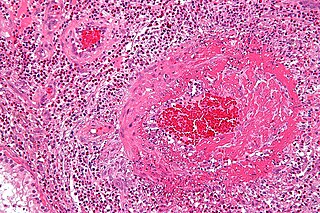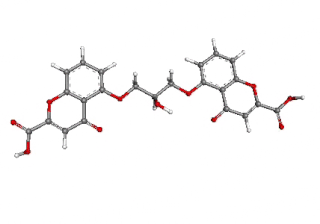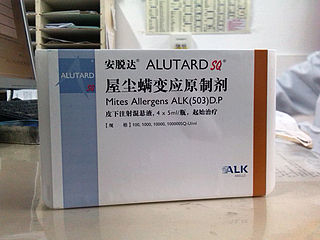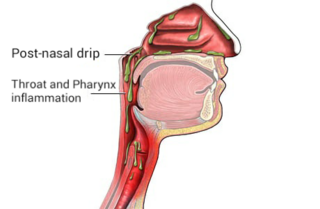Related Research Articles

Allergies, also known as allergic diseases, are a number of conditions caused by hypersensitivity of the immune system to typically harmless substances in the environment. These diseases include hay fever, food allergies, atopic dermatitis, allergic asthma, and anaphylaxis. Symptoms may include red eyes, an itchy rash, sneezing, a runny nose, shortness of breath, or swelling. Food intolerances and food poisoning are separate conditions.
An allergen is a type of antigen that produces an abnormally vigorous immune response in which the immune system fights off a perceived threat that would otherwise be harmless to the body. Such reactions are called allergies.

Allergic rhinitis, also known as hay fever, is a type of inflammation in the nose that occurs when the immune system overreacts to allergens in the air. Signs and symptoms include a runny or stuffy nose, sneezing, red, itchy, and watery eyes, and swelling around the eyes. The fluid from the nose is usually clear. Symptom onset is often within minutes following allergen exposure, and can affect sleep and the ability to work or study. Some people may develop symptoms only during specific times of the year, often as a result of pollen exposure. Many people with allergic rhinitis also have asthma, allergic conjunctivitis, or atopic dermatitis.

Rhinitis, also known as coryza, is irritation and inflammation of the mucous membrane inside the nose. Common symptoms are a stuffy nose, runny nose, sneezing, and post-nasal drip.

Eosinophilic granulomatosis with polyangiitis (EGPA), formerly known as allergic granulomatosis, is an extremely rare autoimmune condition that causes inflammation of small and medium-sized blood vessels (vasculitis) in persons with a history of airway allergic hypersensitivity (atopy).

Zafirlukast is an orally administered leukotriene receptor antagonist (LTRA) used for the chronic treatment of asthma. While zafirlukast is generally well tolerated, headache and stomach upset often occur. Some rare side effects can occur, which can be life-threatening, such as liver failure. Churg-Strauss syndrome has been associated with zafirlukast, but the relationship isn't thought to be causative in nature. Overdoses of zafirlukast tend to be self-limiting.

Cromoglicic acid (INN) — also referred to as cromolyn (USAN), cromoglycate, or cromoglicate — is traditionally described as a mast cell stabilizer, and is commonly marketed as the sodium salt sodium cromoglicate or cromolyn sodium. This drug prevents the release of inflammatory chemicals such as histamine from mast cells.

Aspirin exacerbated respiratory disease (AERD), also termed aspirin-induced asthma, is a medical condition initially defined as consisting of three key features: asthma, respiratory symptoms exacerbated by aspirin and other nonsteroidal anti-inflammatory drugs (NSAIDs), and nasal polyps. The symptoms of respiratory reactions in this syndrome are hypersensitivity reactions to NSAIDs rather than the typically described true allergic reactions that trigger other common allergen-induced asthma, rhinitis, or hives. The NSAID-induced reactions do not appear to involve the common mediators of true allergic reactions, immunoglobulin E or T cells. Rather, AERD is a type of NSAID-induced hypersensitivity syndrome. EAACI/WHO classifies the syndrome as one of five types of NSAID hypersensitivity or NSAID hypersensitivity reactions.

Allergen immunotherapy, also known as desensitization or hypo-sensitization, is a medical treatment for environmental allergies, such as insect bites, and asthma. Immunotherapy involves exposing people to larger and larger amounts of allergen in an attempt to change the immune system's response.

Atopy is the tendency to produce an exaggerated immunoglobulin E (IgE) immune response to otherwise harmless substances in the environment. Allergic diseases are clinical manifestations of such inappropriate, atopic responses.

Post-nasal drip (PND), also known as upper airway cough syndrome (UACS), occurs when excessive mucus is produced by the nasal mucosa. The excess mucus accumulates in the back of the nose, and eventually in the throat once it drips down the back of the throat. It can be caused by rhinitis, sinusitis, gastroesophageal reflux disease (GERD), or by a disorder of swallowing. Other causes can be allergy, cold, flu, and side effects from medications.

Levocetirizine, sold under the brand name Xyzal among others, is an antihistamine used for the treatment of allergic rhinitis and long term hives of unclear cause. It is less sedating than older antihistamines. It is taken by mouth.

Rhinorrhea or rhinorrhoea is the free discharge of a thin nasal mucus fluid. The condition, commonly known as a runny nose, occurs relatively frequently. Rhinorrhea is a common symptom of allergies or certain viral infections, such as the common cold. It can be a side effect of crying, exposure to cold temperatures, cocaine abuse, or withdrawal, such as from opioids like methadone. Treatment for rhinorrhea is not usually necessary, but there are a number of medical treatments and preventive techniques available.

Azelastine, sold under the brand name Optivar among others, is a medication primarily used as a nasal spray to treat allergic rhinitis and as eye drops for allergic conjunctivitis. Other uses may include asthma and skin rashes for which it is taken by mouth. Onset of effects is within minutes when used in the eyes and within an hour when used in the nose. Effects last for up to 12 hours.

Mometasone, also known as mometasone furoate, is a steroid medication used to treat certain skin conditions, hay fever, and asthma. Specifically it is used to prevent rather than treat asthma attacks. It can be applied to the skin, inhaled, or used in the nose. Mometasone furoate, not mometasone is used in medical products.

Allergic inflammation is an important pathophysiological feature of several disabilities or medical conditions including allergic asthma, atopic dermatitis, allergic rhinitis and several ocular allergic diseases. Allergic reactions may generally be divided into two components; the early phase reaction, and the late phase reaction. While the contribution to the development of symptoms from each of the phases varies greatly between diseases, both are usually present and provide us a framework for understanding allergic disease.
The use of podiatry drills, in the absence of engineering controls and personal protective equipment, is an occupational hazard to the healthcare provider. Nail dust collected during foot care procedures performed in office settings has been found to contain keratin, keratin hydrolysates, microbial debris, and viable fungal elements, including dermatophytes and saprotrophs. Exposure to nail dust and the associated risk will vary with the policies and practices in place, the type of podiatry drill used, therapy technique, frequency of procedures, personal protective equipment utilized and the use of ventilation systems.

Fluticasone furoate is a corticosteroid for the treatment of non-allergic and allergic rhinitis administered by a nasal spray. It is also available as an inhaled corticosteroid to help prevent and control symptoms of asthma. It is derived from cortisol. Unlike fluticasone propionate, which is only approved for children four years and older, fluticasone furoate is approved in children as young as two years of age when used for allergies.
Sociedad Española de Inmunología Clínica, Alergología y Asma Pediátrica (SEICAP), the Spanish Society of Pediatric Allergy, Asthma and Clinical Immunology, is a scientific, non-profit organization, whose aims are to develop and disseminate the knowledge of allergic and immunologic diseases that affect children. Since June 2012 SEICAP has been recognized as a Public Interest Entity. As the most important part of their field of study we can include childhood asthma, rhinitis and conjunctivitis, anaphylaxis, atopic dermatitis, contact dermatitis, urticaria and angioedema, food allergy, drug allergy, allergy to latex, allergy to insect stings, primary immunodeficiency, and other disorders. These conditions are very frequent in children, especially in developed countries, and generate a considerable expenditure on health, especially increasing since the 1990s.
Alcohol-induced respiratory reactions, also termed alcohol-induced asthma and alcohol-induced respiratory symptoms, are increasingly recognized as a pathological bronchoconstriction response to the consumption of alcohol that afflicts many people with a "classical" form of asthma, the airway constriction disease evoked by the inhalation of allergens. Alcohol-induced respiratory reactions reflect the operation of different and often racially related mechanisms that differ from those of classical, allergen-induced asthma.